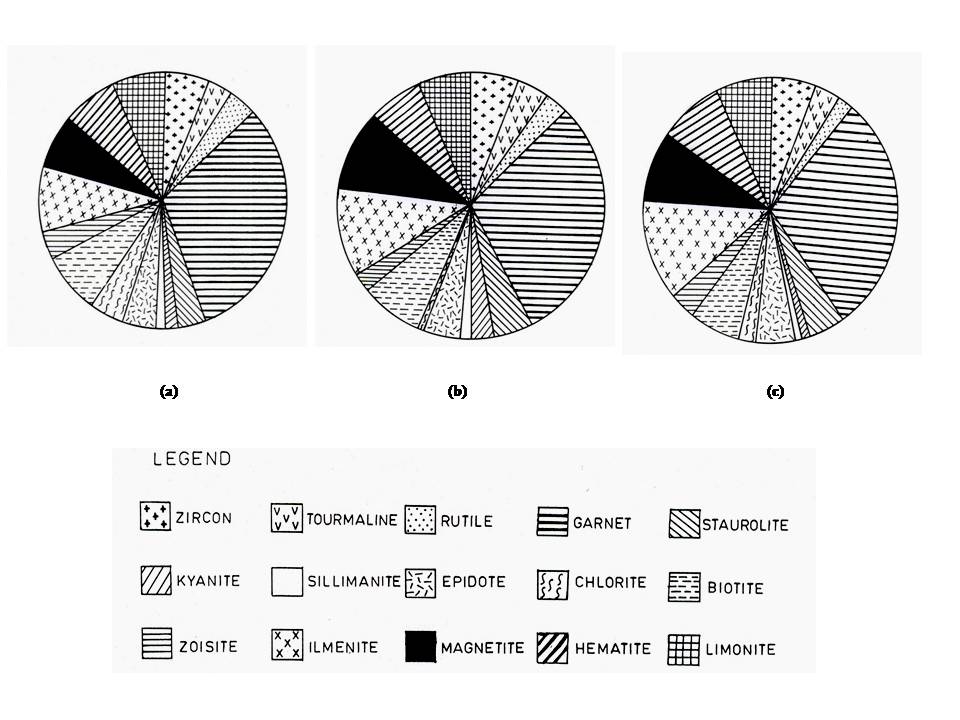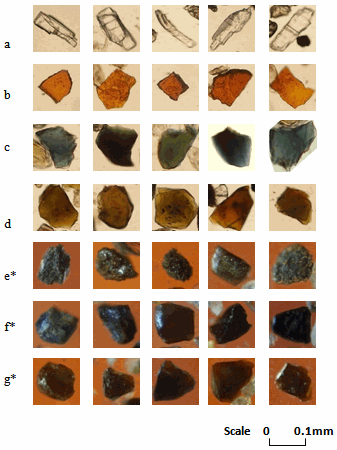-
Paper Information
- Next Paper
- Previous Paper
- Paper Submission
-
Journal Information
- About This Journal
- Editorial Board
- Current Issue
- Archive
- Author Guidelines
- Contact Us
Geosciences
p-ISSN: 2163-1697 e-ISSN: 2163-1719
2012; 2(6): 157-163
doi: 10.5923/j.geo.20120206.02
Heavy Mineral Assemblage of the Pinjor Formation of the Northwestern Himalaya and its Significance in Deciphering the Provenance of the Sediments
Mahavir Singh
Department of Geology, Kurukshetra University, Kurukshetra, 136119, India
Correspondence to: Mahavir Singh , Department of Geology, Kurukshetra University, Kurukshetra, 136119, India.
| Email: |  |
Copyright © 2012 Scientific & Academic Publishing. All Rights Reserved.
Dense mineral assemblage of the Late Pliocene-Early Pleistocene Pinjor Formation of the type area is of immense significance in determining the provenance of the sediments their correlation and understanding the diagenetic changes. Heavy liquid separation technique has been used to isolate the heavies. 82 representative samples showing significant variation in grain size and lithology were selected for incident and reflected light petrography. The heavy mineral assemblage of the Pinjor Formation in the type area comprises zircon, tourmaline, rutile, garnet, staurolite, kyanite, sillimanite, epidote, chlorite/ chloritoid, biotite and zoisite amongst the non-opaque minerals while the opaque minerals include ilmenite, magnetite, hematite and limonite. Garnet is the most abundant heavy mineral followed by biotite and zoisite and others among the non opaque minerals, while ilmenite, magnetite and hematite dominate the non-opaque heavies. Percentage frequency of the various minerals in the measured sections of the Pinjor Formation has been worked out. It is concluded that the sediments comprising the Pinjor Formation are immature, were derived from the lithostratigraphic units exposed to the North of the foredeep and exhibit little affects of intrastratal solutions.
Keywords: Heavy Minerals, Pinjor, Himalaya, Provenance, Siwalik
Cite this paper: Mahavir Singh , "Heavy Mineral Assemblage of the Pinjor Formation of the Northwestern Himalaya and its Significance in Deciphering the Provenance of the Sediments", Geosciences, Vol. 2 No. 6, 2012, pp. 157-163. doi: 10.5923/j.geo.20120206.02.
Article Outline
1. Introduction
- Minerals having density more than 2.89 are designated as dense/heavy minerals. These minerals are both opaque and non-opaque in character. Dense mineral assemblage is of immense utility in deciphering the source rock(s) of sediments; correlation of unfossiliferous strata ; working out paleo-environmental and paleo-tectonic condition(s) ;studying the diagenetic changes experienced by the sediments ; analyzing the mineralizing modifications on account of intrastratal solutions ; and basin analysis studies. Heavy minerals show variation in different microenvironments [1],[2]. The Siwalik Group is exposed in a linear fashion along the Himalayan foothills for a distance of about 2400 Km. from near Jammu in the West to near Tripura in the East. The Late Pliocene-Early Pleistocene Pinjor Formation (1.7 Ma – 2.5 Ma) of Upper Siwalik Subgroup is very well exposed in the type area Pinjor and surrounding regions (Fig.1). The Pinjor Formation (Matuyama magnetic chron) in the type Area Pinjor has been divided into three members namely the Kona Clay Member (94 m – 324 m), Tanda Bhagwanpur Wacke Member (309 m - 917 m) and the Chauki Nadah Pebbly Bed Member (394 m - 670 m)[3]. The Formation attains a thickness of 703 m to 1800 m. It overlies the TatrotFormation (2.5 Ma – 5.6 Ma) and is underlain by the Boulder Conglomerate Formation (0.7 Ma – 1.7 Ma). The Formation has a conformable gradational contact with underlying and overlying formations.Lithologically, the Pinjor Formation is made up of light-yellow to chocolate-brown, moderately to weakly indurated, sandstones and variegated clays and siltstones. Pebbly sandstone beds are frequently interlayered between the massive sandstones of the Pinjor Formation. The Pinjor Formation is characterized by the dominance of poorly indurated argillaceous rocks and clays which are inter-bedded with pebble beds. During the last decade the sedimentology of the Siwalik Group has been examined by Chaudhri[4], Suresh et al.[5], Kumar et al.[6], Ullan et al.[7] and others. In this paper, an attempted has been made, to work out the dense mineral assemblage of the rocks comprising the Pinjor Formation, exposed in the type area Pinjor and adjoining regions to determine the provenance of the sediments.
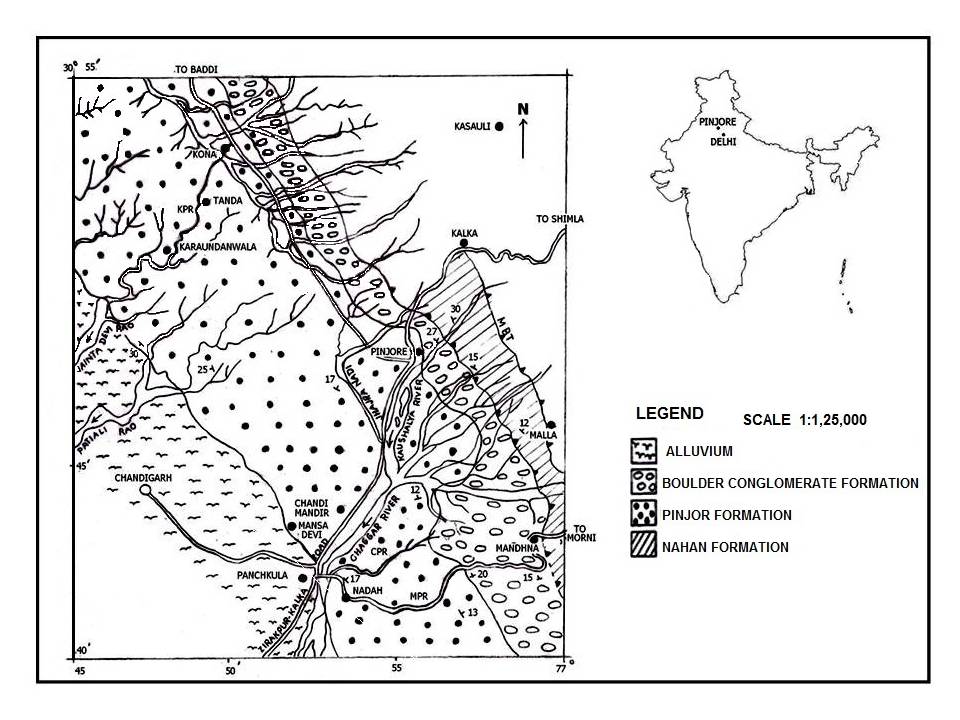 | Figure 1. Geological Map of the Pinjor Formation in the type area Pinjor and surrounding regions |
2. Analytical Techniques
- About 82 representative samples from the three measured sections and some random samples were selected for their heavy mineral analysis. About 100 gm of each of the selected samples was crushed to (–80) mesh ASTM sieve size by rubber pestle and mortar. The friable rocks were disaggregated into individual grains by fingers. Care was taken to ensure that the last grain in the sample passed through the sieve. The crushed sample was reduced to about 20 gm by coning and quartering. After weighing the samples in an electronic balance, these were transferred to numbered china dishes. The clay fraction was removed by repeated washing with water and subsequent decantation. The sand sized fraction was treated with mild acetic acid to remove carbonate and ferruginous coating. The samples were then boiled with distilled water and dried in an oven at low temperature. The cleaned and dried samples were put in a 150 ml. conical separating funnel half filled with bromoform which is being used as a heavy liquid for mineral separation. The separation of heavy minerals was carried out by gravity separation method. The mixture was stirred at regular intervals of time so as to ensure complete separation of heavy and light fractions and heavy minerals were allowed to settle for 72 hours. The heavy fractions were removed onWhatman filter paper No. 4. These were washed with absolute alcohol and dried in an oven at low temperature. Permanent mounts were prepared for all the heavy mineral samples and total count was made in each case. The frequency distribution of the various minerals in different sections is represented by pie diagrams (Fig.2) and bar diagrams (Figs. 3 and 4).
3. Mineralogy and Distribution
- The non-opaque heavy mineral assemblage of the rocks of the Pinjor Formation in the type area Pinjor and surrounding regions comprises zircon, tourmaline, rutile, garnet, staurolite, kyanite, sillimanite, epidote, chlorite/ chloritoid, biotite, zoisite and the opaque minerals include ilmenite, magnetite, hematite and limonite. The important characters of the various minerals, as seen in rocks of the Pinjor Formation, are summarized herein. ZirconIt constitutes 5.41% to 5.93% of the heavy mineral assemblage and occupies the third position in order of abundance. The colorless to light pink, pyramidal, rounded and broken fragments of subangular to subrounded zircon (Plate I, a) do not show much variation in the Berwala – Mandhna section (Fig. 3a), Ghaggar River - Chauki Nadah section (Fig. 3b), Kona - Karaundanwala section (Fig. 4a) and the random samples (Fig. 4b).TourmalineTourmaline constitutes 3.23% to 3.95% of the heavies. The honey-yellow to light brown and pale green to dark grey, pyramidal, angular to sub-angular prismatic grains (Plate I, b) vary from 1.66% to 6.66 in the three measured sections and the random samples (Figs. 3 and 4).RutileIt constitutes 2.50% to 5.00% of the heavy mineral assemblage. The deep brick-red to honey-yellow, subangular to subrounded, weakly pleochroic (Plate I, c) rutile grains do not show much variation in the Berwala - Mandhna, the Ghaggar River - Chauki Nadah and the Kona - Karaundanwala Sections and the random samples (Figs. 3 and 4).GarnetGarnet is the most dominant heavy mineral constituting 29.38% to 31.77% of the heavy mineral assemblage. It occupies the first position in order of abundance. The grains are colorless to pale brown in appearance and sub-angular to sub-rounded in outline (Plate I, d). In the Kona - Karaundanwala section, the percentage of garnet varies from 24.22% to 40.05% (Fig. 4a), while in other two sections it varies from 23.38% to 36.16% (Figs. 3b and 4a). StauroliteIt constitutes 1.66% to 6.66% of the heavies. Staurolite grains exhibit various tints of golden yellow and brown colour and occur as sub-angular to sub-rounded broken fragments (Plate I, e). In the Berwala - Mandhna section (Fig. 3a) the staurolite grains vary from1.66% to 5.00%, while in other two sections these vary from 2.50% to 5.83% (Figs. 3b and 4a).KyaniteKyanite constitutes 0.83% to 4.16% of the heavy mineral assemblage. It occurs as elongated, colourless grains with rectangular outline (Plate I, f). It does not show much variation in the Berwala – Mandhna, the Ghaggar River - Chauki Nadah and the Kona - Karaundanwala sections and the random samples (Figs. 3 and 4). SillimaniteSillimanite constitutes 0.83% to 2.50% of the heavies. It occurs as irregular to short prismatic grains which are marked by longitudinal splitting and striations parallel to the length of the grains (Plate II, a). The heavy mineral does not show much variation in the Berwala – Mandhna, the Ghaggar River - Chauki Nadah and the Kona - Karaundanwala sections and the random samples (Figs. 3 and 4). EpidoteThe percentage of epidote varies from 2.50% to 6.66%. The sub-angular to sub-rounded grains of epidote are pale greenish-yellow to lemon-yellow and non-pleochroic (Plate II, b). In the Berwala - Mandhna Section the epidote grains vary from 2.50% to 6.66% (Fig. 3a), while in other two sections these vary from 3.33% to 5.83% (Figs. 3b and 4a).Chlorite / ChloritoidChlorite constitutes 0.83% to 19.16% of the heavy mineral assemblage. The mineral grains are sub-angular to sub-rounded in outline. The cleavage flakes of chlorite exhibit bluish-green to green colour (Plate II, c). Chlorite shows considerable variation in three sections. The percentage of the mineral reaches a high 19.16% in the Berwala - Mandhna section (Fig. 3a), while it is 2.50% in the Kona - Karaundanwala section (Fig. 3b) and 3.33% in the Ghaggar River - Chauki Nadah section (Fig. 4a).BiotiteIt constitutes 5.00% to 14.16% of the heavy mineral assemblage and occupies the second position in order of abundance. The flaky biotite grains are pale-yellow to reddish-brown in colour (Plate II, d). In the Berwala - Mandhna section the biotite grain vary from 5.00% to 14.16% (Fig. 3a), while in other two sections these vary from 5.00% to 10.83% (Figs. 3b and 4a). ZoisiteZoisite constitutes 0.83% to 9.16% of the heavy mineral assemblage. It occurs as sub-angular to sub-rounded grains having brown to dark brown colour. The mineral is non-pleochroic and has moderate to high relief. In the Ghaggar River - Chauki Nadah section the zoisite grain vary from 1.66% to 6.66%, while in other two sections these vary from 0.83% to 9.16% .The opaque mineral fraction includes ilmenite, magnetite, hematite and limonite. IlmeniteIlmenite is the most dominant opaque mineral. Its percentage varies from 5.00% to 15.83%. Under reflected light, the sub-angular to sub-rounded opaque grains exhibit purple to purplish-brown colour with white spots (Plate II, e). The mineral percentage varies from 6.66% to 10.83% in the Berwala – Mandhna section to 15.83% in the Ghaggar River - Chauki Nadah section and the Kona - Karaundanwala section and the random samples (Figs. 3 and 4).MagnetiteIt constitutes 5.00% to 11.66% of the heavies. The sub-angular to sub-rounded grains exhibit bluish-black colour under reflected light (Plate II, f). The mineral grain do not show much variation in the Berwala – Mandhna, the Ghaggar River - Chauki Nadah and the Kona - Karaundanwala sections and the random samples (Figs. 3 and 4).HematiteThe hematite grains show deep red to cherry red colour in strong incident light (Plate II, g). The mineral constitutes 5.00% to 10.83% of the heavy mineral assemblage. The percentage of hematite varies from 5.83% to 10.83% in the Berwala - Mandhna section and the Ghaggar River - Chauki Nadah section and 5.00% to 7.50% in theKona-Karaundanwala section and the random samples (Figs. 3 and 4).Limonite It constitutes 5.00% to 9.16% of the heavies. The ocher-yellow colored mineral represents a group of hydrated iron oxide minerals. The subangular to subrounded grains of limonite form 5.00% to 7.50% of the heavies in the Kona - Karaundanwala section and 5.00% to 6.16% in the Berwala - Mandhna section and Ghaggar River - Chauki Nadah section and the random samples (Figs. 3 and 4).
 | Figure 3. Bar diagrams showing the average percentage frequency distribution of the heavy minerals in the type area Pinjor. (a) Berwala - Mandhna Section (b) Ghaggar River - Chauki Nadah Section |
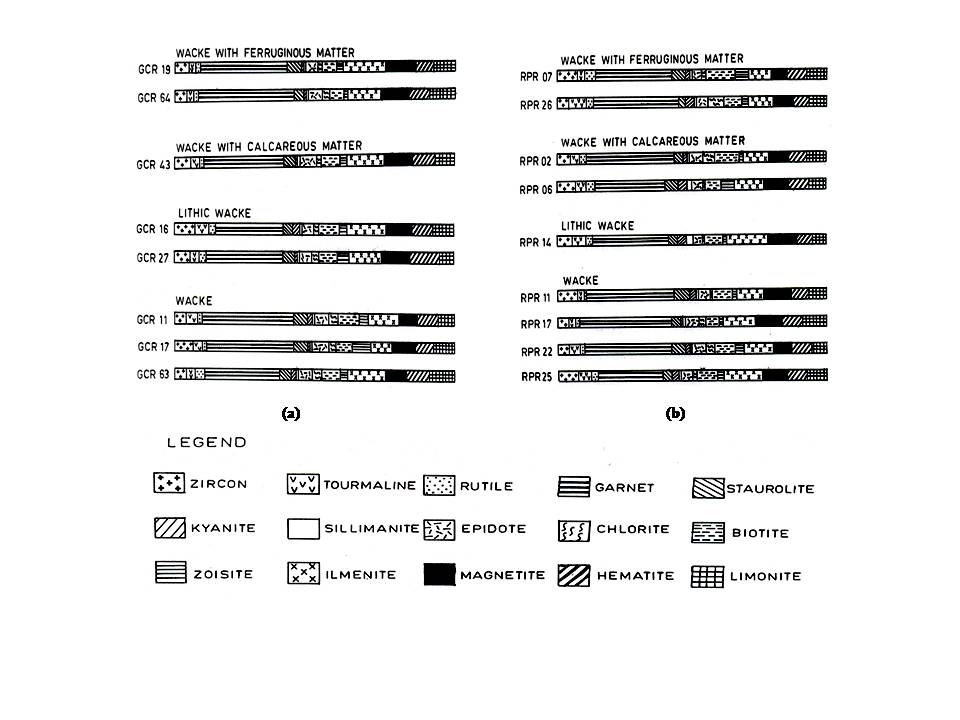 | Figure 4. Bar diagrams showing the average percentage frequency distribution of the heavy minerals in the type area Pinjor. (a) Kona - Karaundanwala Section (b) Random Samples |
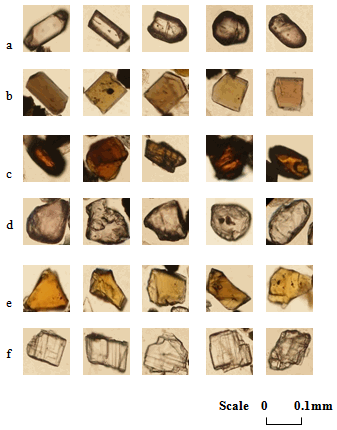 | Plate I. Photomicrographs of dense minerals in Pinjor Formation of the type area Pinjor. (a) Zircon (b) Tourmaline (c) Rutile (d) Garnet (e) Staurolite (f) Kyanite |
4. Conclusions
- Heavy mineral assemblage is controlled by a number of factors such as nature of the parent rocks, vagaries of climatic conditions during weathering, relative solubility and stability of the various detrital minerals, their mineralogy, abrasion history, their density, size, sorting and past depositional changes experienced by the sediments. In sediments which have been deposited in a fore-deep after relatively short transport and a quick pace of sedimentation, the heavy mineral assemblage primarily reflects the mineralogical character of the source rocks.The heavy mineral assemblage of the Pinjor Formation exposed in the type area Pinjor and surrounding regions comprises zircon, tourmaline, rutile, garnet, staurolite, kyanite, sillimanite, epidote, chlorite/chloritoid, biotite and zoisite in the non opaque fraction and ilmenite, magnetite, hematite and limonite in the opaque fraction.Garnet is the most abundant heavy mineral followed by biotite and zircon and others in the non opaque categories (Fig. 2). Among the opaque minerals ilmenite dominates the scene and is closely followed by the other three minerals. The mineral assemblage garnet, staurolite, kyanite, sillimanite, epidote, zoisite, magnetite is suggestive of derivation of a major part of detritus from high grade metamorphic rocks. The presence of angular brown colored tourmaline grains with well developed prismatic and pyramidal faces reflects the first cycle nature of a portion of detritus and short transportation history. Presence of angular zircon grains having nearly euhedral shape suggests their derivation from acid igneous rock. Igneous origin of zircon has been suggested by number of workers including [8],[9],[10],[11] and[12]. Epidote, zoisite and staurolite appear to have been derived from meso-zone metamorphic rocks. Heinrich[13] recorded that the assemblage biotite, chlorite/chloritoid, epidote, tourmaline are derived from low and medium grade metamorphic parent rocks.Feo-codecido[14] and Pettijohn et al.[15] suggested that the mineral suite comprising epidote, staurolite, chlorite/chloritoid appears to have its home in rocks that have experienced dynamothermal metamorphism. The suite magnetite, ilmenite, rutile and leucoxene might have been contributed by basic igneous rocks. Presence of sub-rounded heavy minerals is suggestive of the presence of reworked sediments. Hematite and limonite appear to have been contributed by sedimentary rocks. A portion of these minerals might have an authigenic origin. The overall heavy mineral assemblage of the Pinjor Formation is suggestive of the facts that a major part of sediments were derived from high grade metamorphic rocks with a few inputs from igneous rocks. Some of the unstable minerals like olivine, augite, hornblende etc. might have been destroyed. The sediments are multicyclic in nature. Similar observation have been made for the sediments of the Siwalik group by Chaudhri[16],[17],[18] and[19]. Chaudhri[20-21], Chaudhri et al.[22] while discussing the heavy mineral assemblage from the Lower, the Middle and the Upper Siwalik Sub-groups recorded an increasing intensity of diastrophism in the Himalaya with decreasing age of the sediments. The heavy mineral assemblage of the Pinjor Formation is also suggestive of derivation of a major part of detritus from metamorphic rocks. A portion of the sediments might have been derived from crystalline rocks. Presence of subrounded heavy mineral grains is indicative of their recycled origin. Hematite and limonite might have been contributed by sedimentary rocks and a part of these may as well be of authigenic origin.The heavy mineral assemblage of the Pinjor Formation comprising unstable and stable minerals indicates their immature nature and little effect of intrastratal solutions. The various lithostratigraphic units exposed to the North of the type area Pinjor in the Shimla Hills include the Siwalik Group, the Sirmur Group, the Infra-Krol and Krol groups, the Jaunsar Group, the Chail Group, the Jutogh Group and the Shimla Group. These groups are composed of sandstones, siltstones, shales, clays, limestones, slates, phyllites, quartzites, schists, gneisses and crystalline rocks. The rocks fragments of these rocks are found in the various lithologies of the three members constituting the Pinjor Formation. The data suggest that the products of weathering of these rocks were transported to a fore-deep basin by streams and streamlets which drained the region during that time.Electron probe studies of individual heavy minerals will be quite helpful in deciphering the parent rock with a greater degree of confidence as also in understanding the paleoenvironmental conditions.
ACKNOWLEDGEMENTS
- The author wishes to record his sincere gratitude to his Research Supervisor Dr. A.R. Chaudhri for his constant support and guidance. The work was carried out atDepartment of Geology, Kurukshetra University, Kurukshetra, India.
 Abstract
Abstract Reference
Reference Full-Text PDF
Full-Text PDF Full-Text HTML
Full-Text HTML